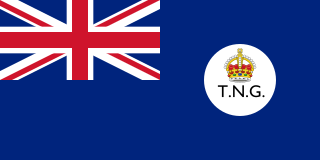
Transport in Papua New Guinea is mainly based around roads and air travel. It is in many cases heavily limited by the mountainous terrain and copious amount of rainfall and frequent severe weather occurring in many locations, such as Lae. The capital, Port Moresby, is not linked by road to any of the other major towns and many highland villages can only be reached by light aircraft or on foot.

Kaiser-Wilhelmsland formed part of German New Guinea, the South Pacific protectorate of the German Empire. Named in honour of Wilhelm I, who reigned as German Emperor from 1871 to 1888, it included the northern part of present-day Papua New Guinea. From 1884 until 1920 the territory was a protectorate of the German Empire. Kaiser-Wilhelmsland, the Bismarck Archipelago, the northern Solomon Islands, the Caroline Islands, Palau, Nauru, the Northern Mariana Islands, and the Marshall Islands comprised German New Guinea.

Morobe Province is a province on the northern coast of Papua New Guinea. The provincial capital and largest city is Lae. The province covers 33,705 km2, with a population of 674,810, and since the division of Southern Highlands Province in May 2012 it is the most populous province. It includes the Huon Peninsula, the Markham River, and delta, and coastal territories along the Huon Gulf. The province has nine administrative districts. At least 101 languages are spoken, including Kâte and Yabem language. English and Tok Pisin are common languages in the urban areas, and in some areas pidgin forms of German are mixed with the native language.

Religion in Papua New Guinea is dominated by various branches of Christianity, with traditional animism and ancestor worship often occurring less openly as another layer underneath or more openly side by side with Christianity. The Catholic Church has a plurality of the population. The courts, government, and general society uphold a constitutional right to freedom of speech, thought, and beliefs. A secular state, there is no state religion in the country, although the government openly partners with several Christian groups to provide services, and churches participate in local government bodies.

The Anglican Church of Papua New Guinea is a province of the Anglican Communion. It was created in 1977 when the Province of Papua New Guinea became independent from the Province of Queensland in the Church of England in Australia following Papua New Guinea's independence in 1975.

The United Church in Papua New Guinea and Solomon Islands is a United church in the Methodist and the Reformed tradition.

The Territory of New Guinea was an Australian-administered United Nations trust territory on the island of New Guinea from 1914 until 1975. In 1949, the Territory and the Territory of Papua were established in an administrative union by the name of the Territory of Papua and New Guinea. That administrative union was renamed as Papua New Guinea in 1971. Notwithstanding that it was part of an administrative union, the Territory of New Guinea at all times retained a distinct legal status and identity until the advent of the Independent State of Papua New Guinea.
The Catholic Church in Papua New Guinea is part of the worldwide Catholic Church, under the spiritual leadership of the Pope in Rome. Papua New Guinea has approximately two million Catholic adherents, approximately 27% of the country's total population.
Steven Garasai Tari, also known as Black Jesus, was a Papua New Guinean religious figure, leader of a Christian-influenced cargo cult, who claimed to be the Messiah or the Christ, and is notorious for alleged rape and murder.

Clawson v. United States, 113 U.S. 143 (1885), was a case regarding a Utah territorial statute which authorized an appeal by a defendant in a criminal action from a final judgment of conviction, which provides that an appeal shall stay execution upon filing with the clerk a certificate of a judge that in his opinion there is probable cause for the appeal, and further provides that after conviction, a defendant who has appealed may be admitted to bail as of right when the judgment is for the payment of a fine only, and as matter of discretion in other cases, does not confer upon a defendant convicted and sentenced to pay a fine and be imprisoned the right, after appeal and filing of certificate of probable cause, to be admitted to bail except within the discretion of the court.
Sio is an Austronesian language spoken by about 3,500 people on the north coast of the Huon Peninsula in Morobe Province, Papua New Guinea. According to Harding and Clark (1994), Sio speakers lived in a single village on a small offshore island until the Pacific War, after which they established four villages on the nearby coast: Lambutina, Basakalo, Laelo, and Balambu. Nambariwa, another coastal village a few miles to the east, is also Sio-speaking.
Thomas Sidney Dixon was a Catholic missionary known for his work with Indigenous peoples. He took up the cause of Max Stuart, an Arrernte Aboriginal convicted of murder in 1959.

MV Rabaul Queen was a passenger ferry owned by the Papua New Guinea company Rabaul Shipping. The ship, built in Japan in 1983, operated on short runs in that country, before being brought to Papua New Guinea in 1998 and plying a regular weekly route between Kimbe, the capital of West New Britain, and Lae, the capital of the mainland province of Morobe.
Yali was a Papua New Guinean coastwatcher, local government councillor, police officer, political activist, prisoner, and soldier. Yali was born near Sor village in the Madang District in then-German New Guinea and died in the same place, by the end of his life in the independent country of Papua New Guinea.

As the township of Lae, in Morobe Province, Papua New Guinea is a relatively new entity, the history of the Lae environs is much older.

House v The King is a decision of the High Court of Australia.

Veen v R is a decision of the High Court of Australia.

Dinsdale v R is an Australian legal case decided in the High Court.

The Martyrs of New Guinea were Christians including clergy, teachers, and medical staff serving in New Guinea who were executed during the Japanese invasion during World War II in 1942 and 1943. A total of 333 church workers including Papuans and visiting missionaries from a range of denominations were killed during the invasion.
















